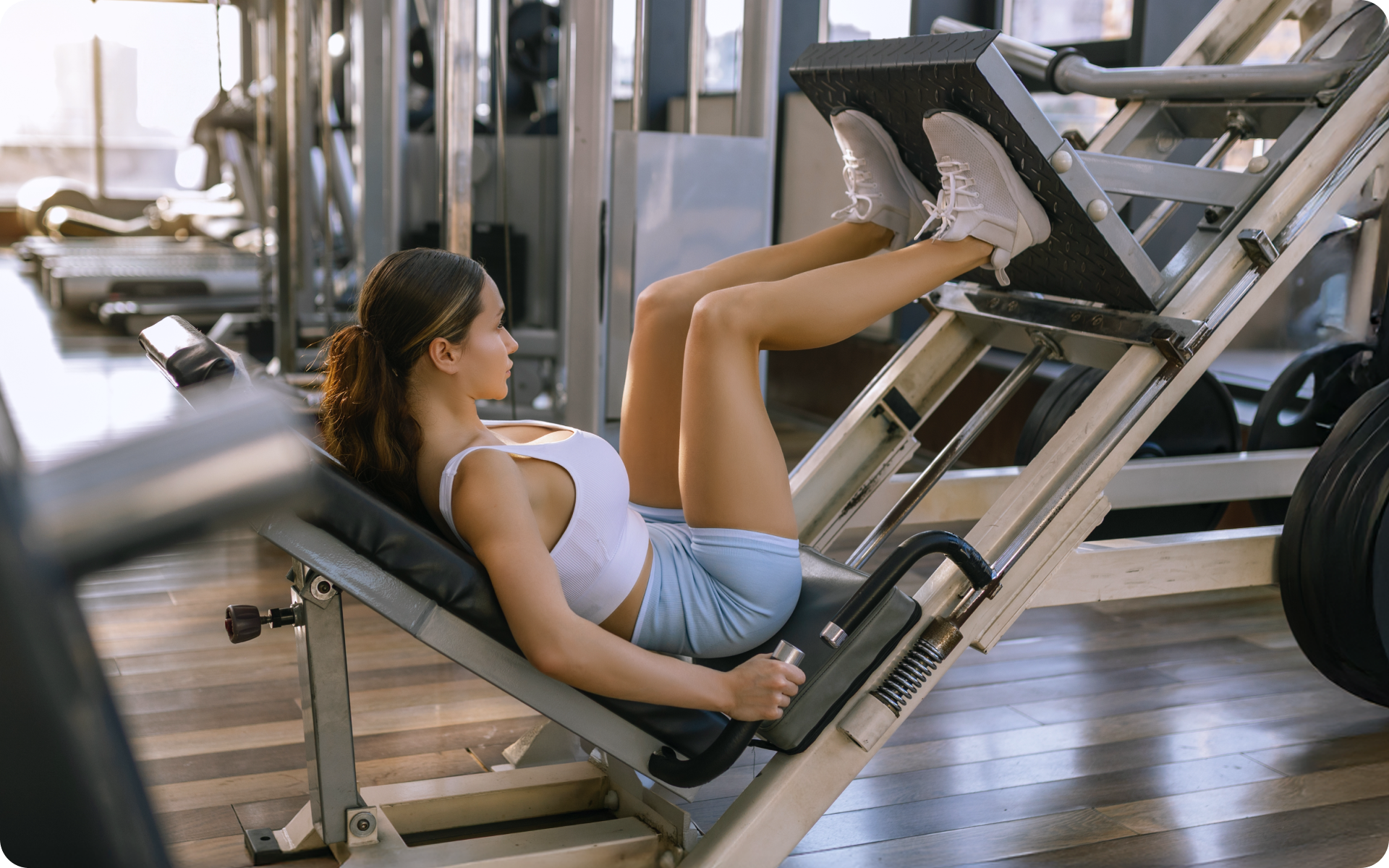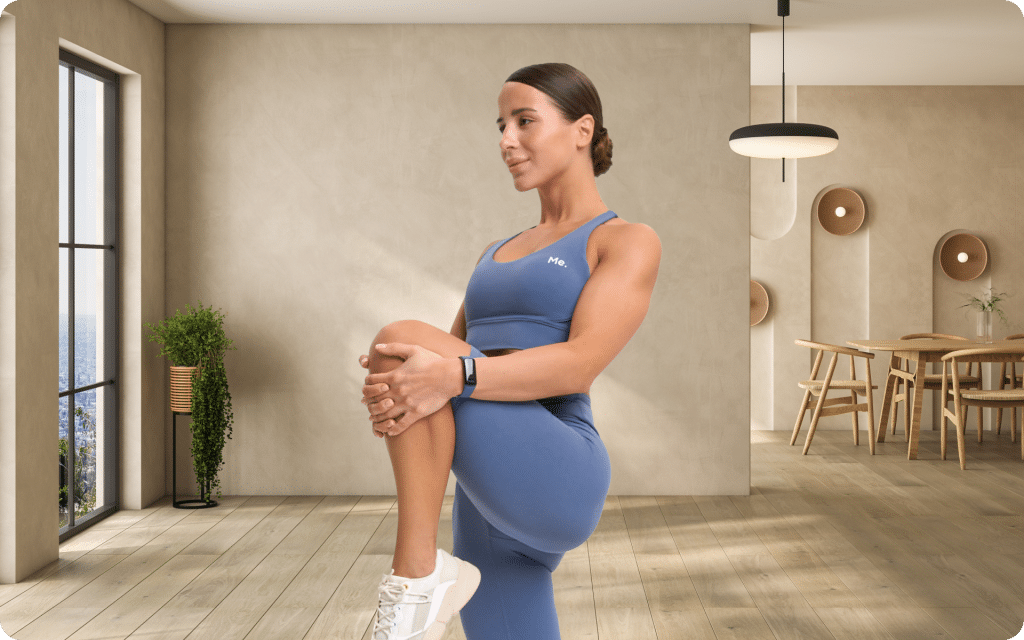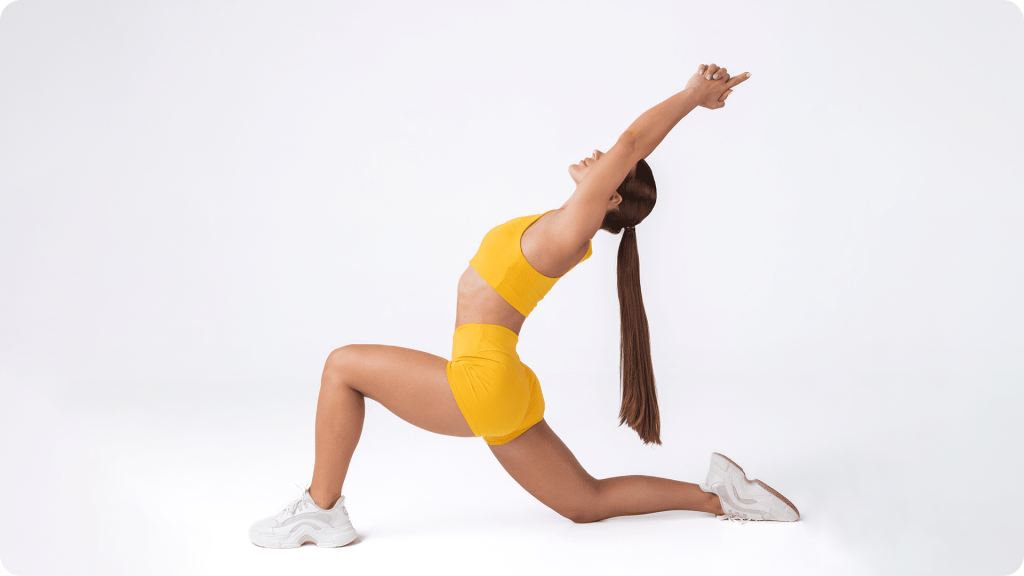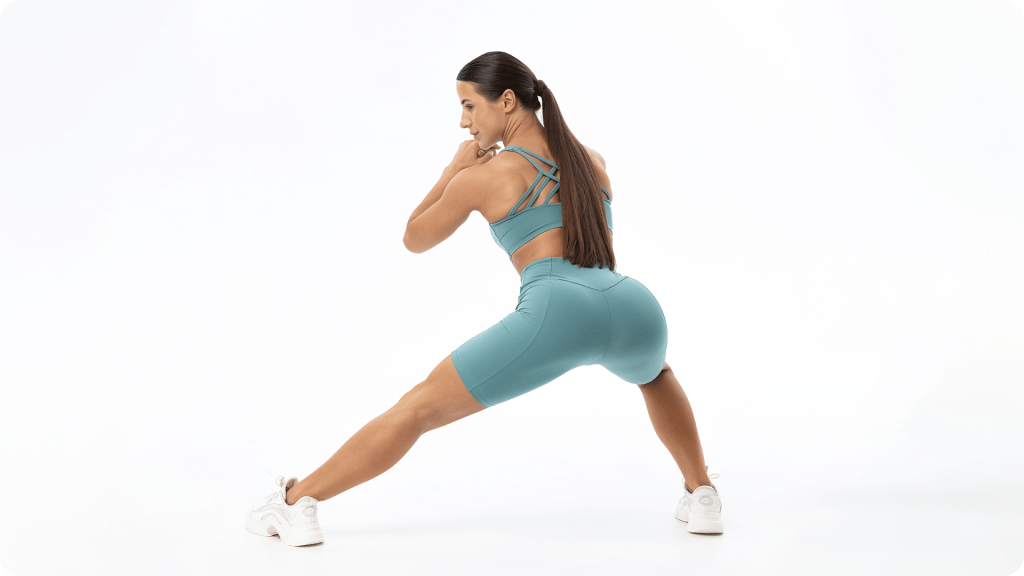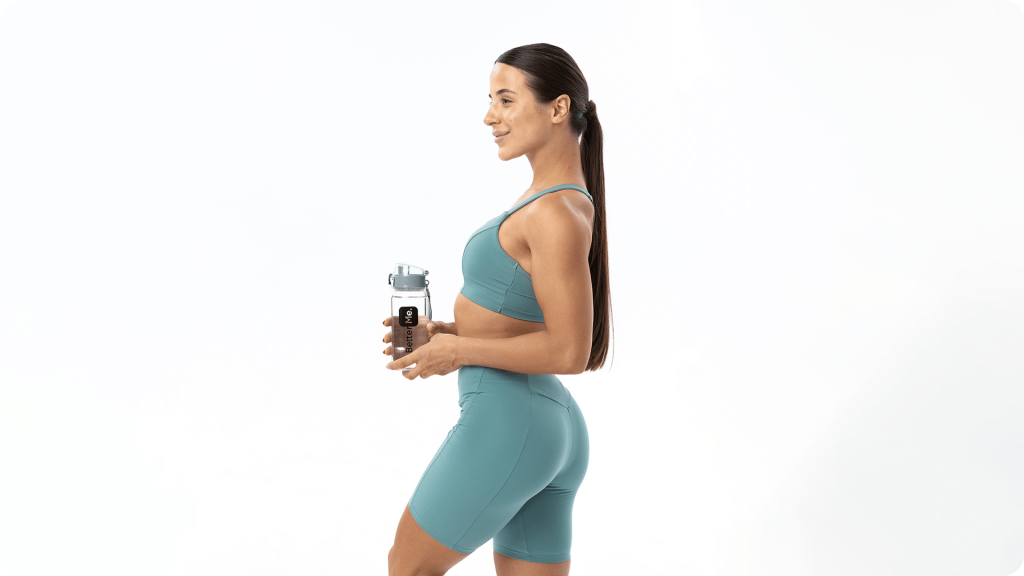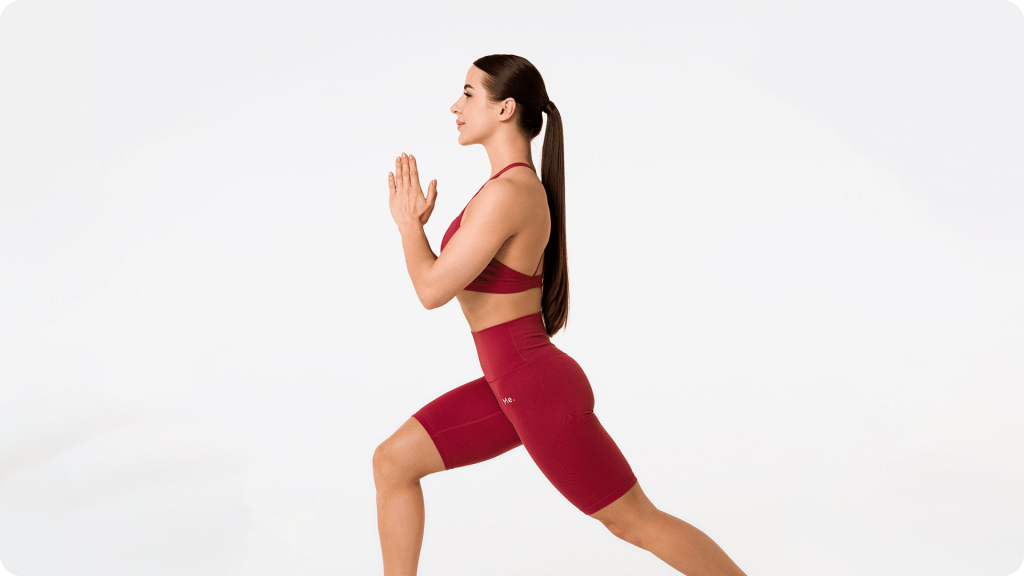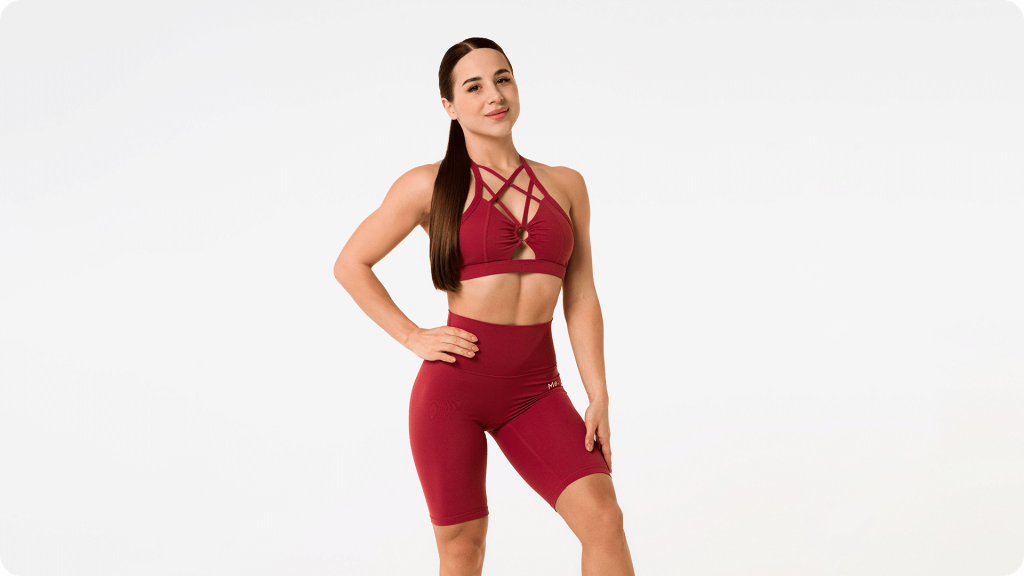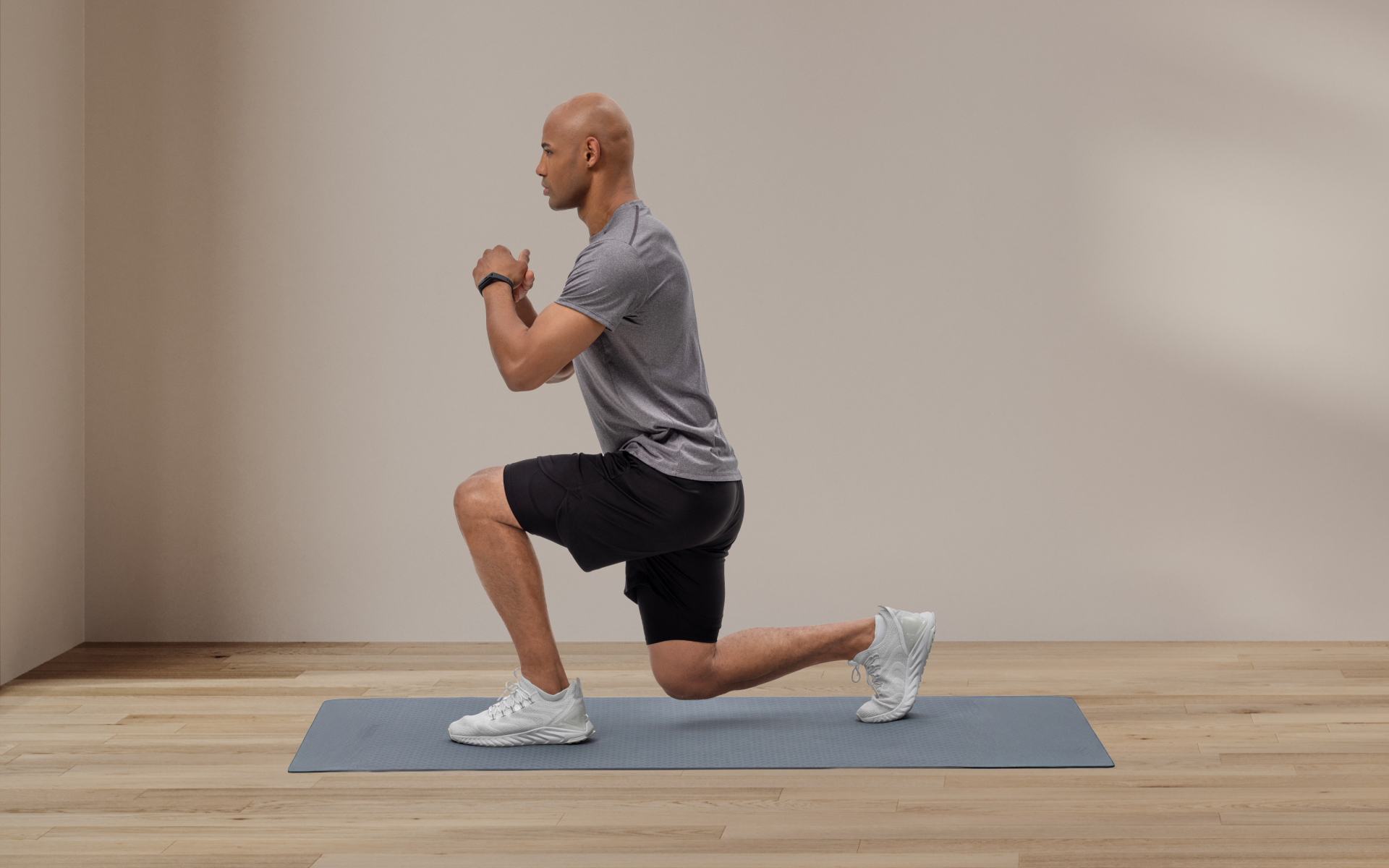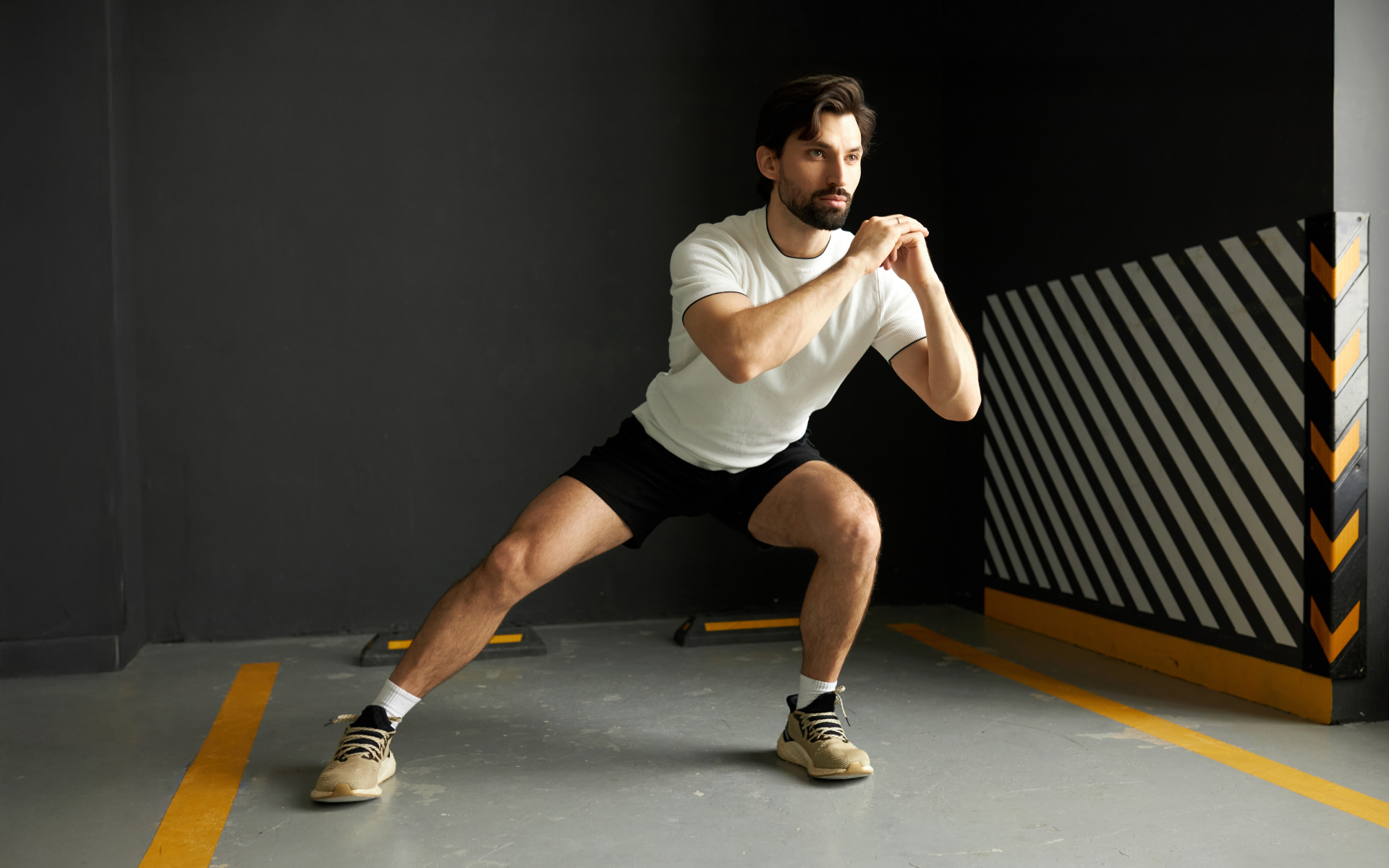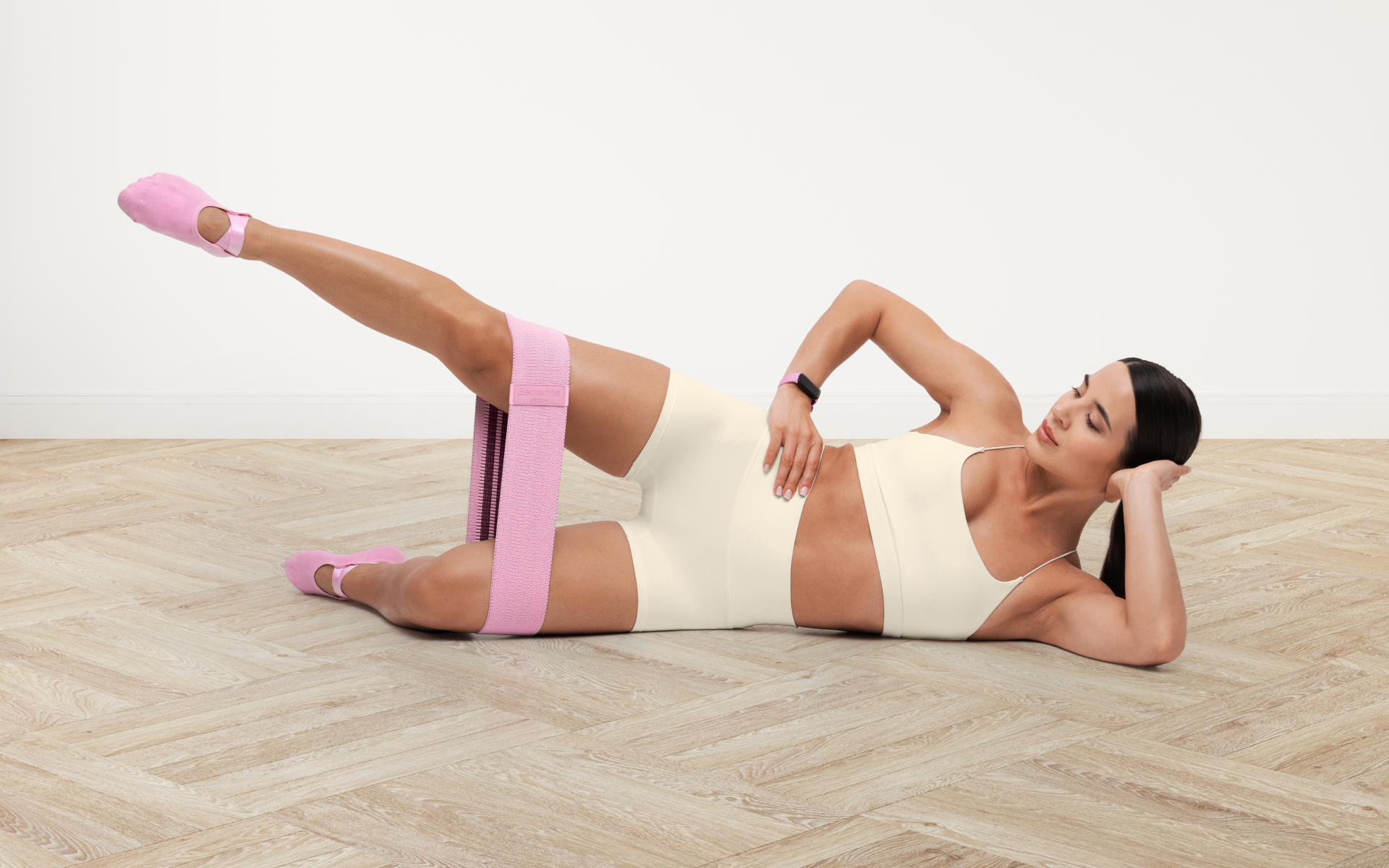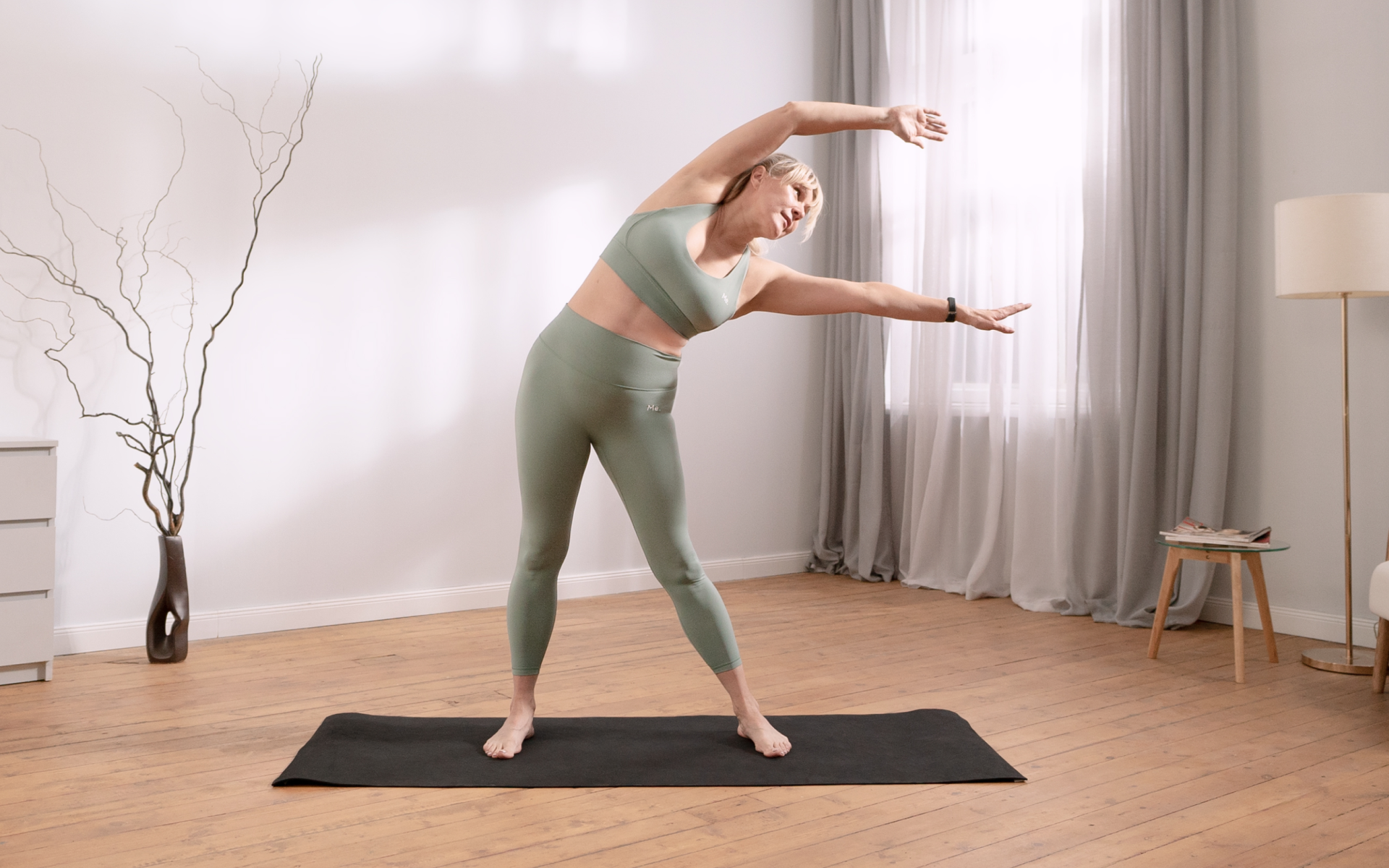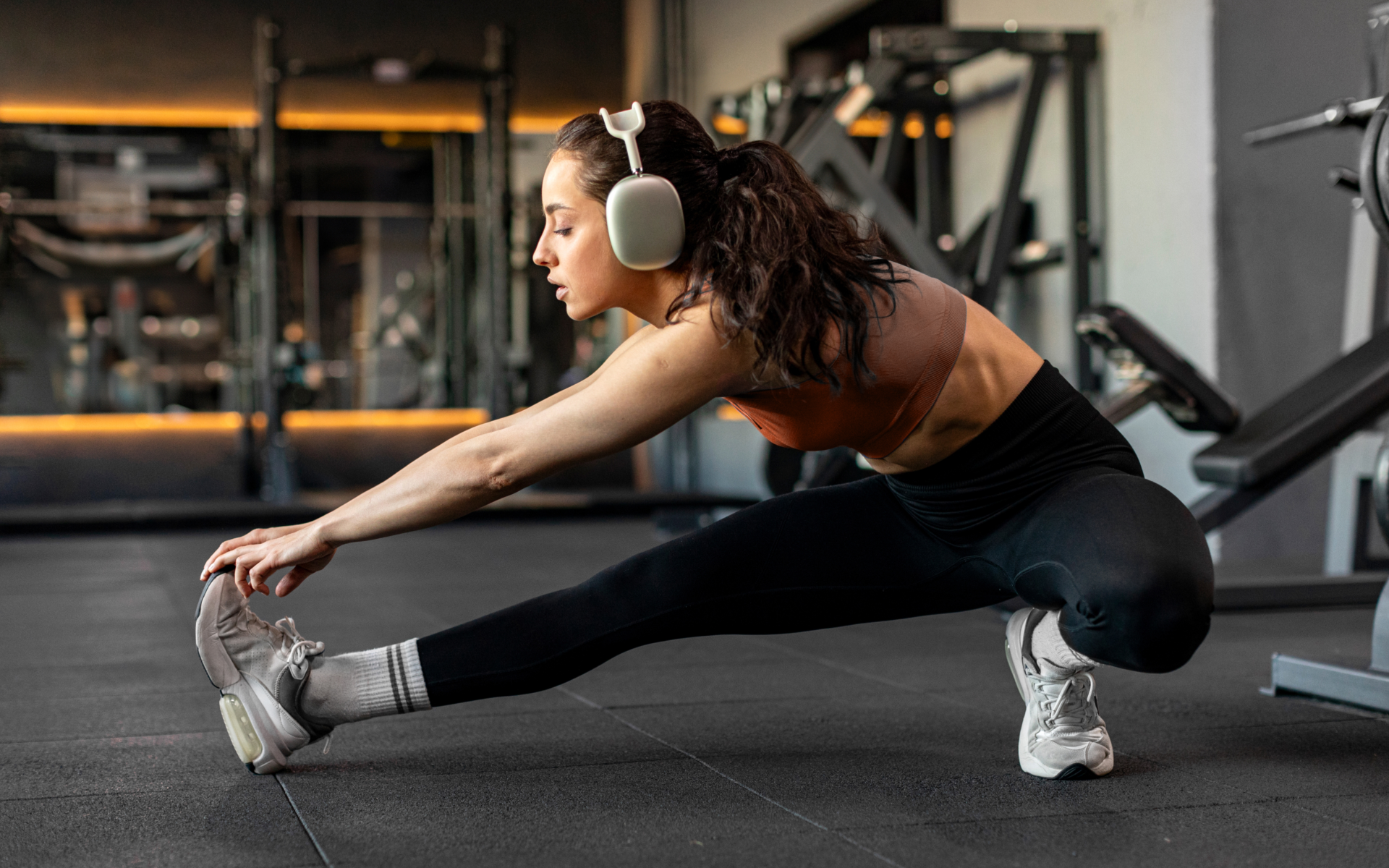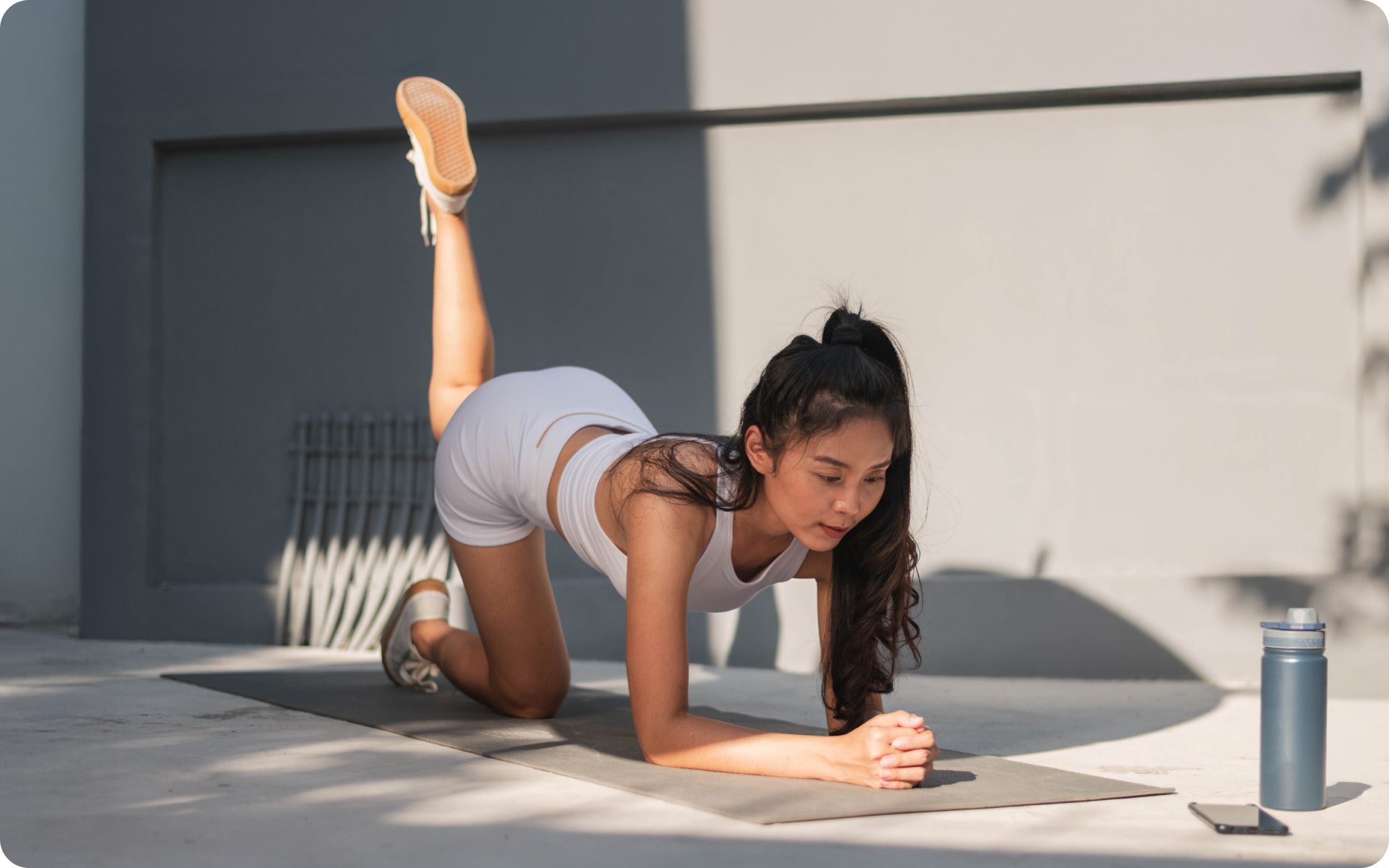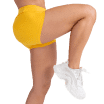Strong legs contribute to improved athletic performance, better balance, enhanced mobility, and injury prevention (1).
For example, robust quadriceps and hamstrings stabilize your knees, which reduces your risk of joint issues (2). Your glutes, the body’s largest muscle group, are pivotal in maintaining posture and generating power for explosive movements (3) Even your smaller muscles, such as those in the calves, play a crucial role in shock absorption and ankle stability (4).
Exercise selection is the key to building a well-rounded and injury-resistant lower body.
The best exercises challenge various muscle groups, replicate functional movement patterns, and allow for progressive overload (gradually increasing resistance to build strength).
Here’s a guide to leg exercises for your next day at the gym.
How to Start Leg Exercises at the Gym as a Beginner
Leg exercises for a beginner start with building a strong foundation. Focus on mastering basic movements such as bodyweight squats, lunges, or using the leg press machine. These exercises are beginner-friendly and help you develop strength while learning proper technique.
Warm up with light cardio and dynamic stretches to prepare your muscles and improve mobility (5). Pay close attention to your form, as this reduces the risk of injury and ensures effective engagement of your muscles, such as your quads, glutes, and hamstrings.
Start with light resistance or just your body weight, and gradually increase the intensity as your confidence and strength grow. If you’re curious about calisthenics leg workout, check out our earlier article
How Should You Properly Prepare for Leg Day at the Gym?
Preparing your body for the demands of leg day involves warming up, stretching dynamically, and activating key muscles. These steps help improve performance, reduce your injury risk, and increase flexibility (5).
Mobility work is about improving how your joints move and how well your muscles work through their full range of motion (6). On leg day, your hips, knees, and ankles play crucial roles in exercises such as squats or lunges.
When these joints lack mobility, your form may suffer, and you may strain surrounding muscles (6). By priming your body, you’ll increase joint stability and ensure muscles such as the glutes, hamstrings, and quads are properly engaged.
Warming up does more than just increase your heart rate – it also raises the temperature of your muscles, which makes them more elastic and less prone to injury. In addition, it increases blood flow, delivering oxygen and nutrients to the working muscles. Most importantly, it prepares your nervous system, sharpening coordination and reaction times for the exercises ahead (7).
1. Light Cardio (5-10 minutes)
Start your session with 5 to 10 minutes of light cardiovascular exercise, such as walking on a treadmill, cycling, or using the elliptical machine. The goal is to increase your heart rate and warm up your body to improve circulation (8).
2. Dynamic Stretching (5-8 minutes)
Dynamic stretches involve controlled, active movements that prepare your muscles and joints for exercise. Unlike static stretching (holding a stretch), dynamic stretching increases muscle temperature and joint flexibility, which makes your body more responsive to movement demands (9).
Reasons why BetterMe is a safe bet: a wide range of calorie-blasting workouts, finger-licking recipes, 24/7 support, challenges that’ll keep you on your best game, and that just scratches the surface! Start using our app and watch the magic happen.
Here are some effective dynamic stretches for leg day:
Leg Swings
- Stand next to a wall for balance.
- Swing one leg forward and backward through a comfortable range of motion as if kicking a ball, keeping your knee extended and your leg straight.
- Perform 10-12 swings per side.
This stretches your hamstrings and hip flexors while activating your hip joint.
Walking Lunges
- Take a big step forward with your right leg, bending your knees to gently stretch the hip flexors and quads.
- Step forward with your left leg, alternating sides for 10-12 reps.
World’s Greatest Stretch
- Step into a lunge position, placing your hands on the floor.
- Rotate your torso, reaching one arm skyward while keeping the other hand grounded.
This stretch opens up your hips, stretches your hamstrings, and engages your spine.
3. Muscle Activation (5-10 minutes)
Muscle activation primes key muscle groups, ensuring they “wake up” and work effectively during your workout. This step also helps prevent smaller, stabilizing muscles from being underutilized, which could lead to overcompensation by larger muscles (10).
Here are some targeted activation exercises:
Glute Bridges
- Lie on your back with your feet flat and your knees bent.
- Squeeze your glutes as you lift your hips off the ground, forming a straight line from your shoulders to your knees.
- Hold for a second at the top, then lower back down. Perform 10-12 reps.
This activates your glutes for exercises such as squats and deadlifts.
Mini Band Lateral Walks
- Place a resistance band just above your knees or around your ankles.
- Bend your knees slightly, keep your chest upright, and take small lateral steps across the room and back. Do 10 steps each way.
- Focus on controlling your trailing leg as it returns to the center of your body. This exercise is all about slowing things down and controlling the resistance of the band.
This targets your gluteus medius, a crucial muscle for hip stability.
Bodyweight Step-Ups
- Find a low platform or step.
- Step up with one leg, driving through the heel, then step back down.
- Repeat for 8-10 reps per side.
Step-ups engage your quads, hamstrings, and glutes while mimicking real-life movements.
4. Practice Form (2-3 minutes)
Before adding weight, perform a few reps of your planned exercises with just your body weight or an empty barbell. This serves as a movement rehearsal, reinforcing proper form. Dialing in your technique early sets you up for success when the workout begins.
For example, you can do squats or Romanian deadlifts with a barbell only.
Read more: Underbutt Workouts That Help Lift, Tone, Sculpt, and Strengthen
What Are Some Effective Beginner-Friendly Leg Exercises at the Gym?
- Squats
Squats are one of the most effective full-body strength movements. They primarily involve the quadriceps, hamstrings, gluteus maximus, and erector spinae. Squats also recruit stabilizing muscles such as the abdominals and adductors (11).
This compound exercise mimics movements such as sitting and standing, which makes it highly functional. The mechanics involve the extension of the hips, knees, and ankles, also known as triple extension, which is essential for athletic performance (11).
How to Perform Squats:
- Stand with your feet shoulder-width apart. Your toes should point slightly outward.
- Position the barbell across your upper traps (high bar) or rear shoulders (low bar). Grip the bar tightly with your hands slightly wider than shoulder-width apart.
- Engage your core by bracing and maintain a proud chest.
- Sit your hips back as you start to descend, bending at the knees. Keep your weight evenly distributed across your feet.
- Lower yourself until your thighs are parallel to the floor or slightly below, ensuring your knees track over your toes.
- Press through your heels to stand back up, fully extending your hips and knees at the top.
- Repeat for the desired number of reps while maintaining control.
- Romanian Deadlifts (RDL)
The Romanian Deadlift targets the hamstrings, gluteus maximus, and erector spinae, with secondary activation of the lats and forearms (12).
The movement emphasizes hip hinging, which stretches and strengthens the posterior chain. This exercise trains eccentric hamstring strength, which is essential for explosive and athletic performance (12).
How to Perform RDLs:
- Stand tall holding a barbell in front of your thighs with an overhand grip. Your hands should be just outside your thighs.
- Keep your feet hip-width apart and maintain a slight bend in your knees.
- Engage your core and retract your shoulder blades to prevent slouching.
- Hinge at the hips by pushing them backward. Lower the barbell down the front of your legs while keeping your back neutral.
- Lower the barbell until you feel a stretch in your hamstrings or until it reaches mid-shin.
- Pause briefly, then drive your hips forward to return to the starting position.
- Repeat with controlled form. Avoid rounding your back or locking your knees.
- Lunges
Lunges work the quadriceps, glutes, and hamstrings, while also improving balance and unilateral stability. The movement challenges the stabilizing muscles of the hips, such as the gluteus medius, and encourages equal strength development in both legs (13).
How to Perform Lunges:
- Stand tall with your feet together. Keep your hands on your hips or hold weights at your sides for added resistance.
- Step forward with one leg, landing with your heel first. Your front knee should be aligned with your toes, forming a 90-degree angle.
- At the same time, your back knee should be lowered close to the ground without touching it.
- Press through the heel of your front foot to push back to the starting position.
- Alternate legs with each repetition.
- Keep your torso upright throughout the movement.
- Leg Press
The leg press isolates the quadriceps, hamstrings, and glutes while minimizing spinal loading (14). The fixed movement path allows you to lift heavier weights safely. The primary action here is knee and hip extension.
How to Perform a Leg Press:
- Sit on the leg press machine with your back and head firmly pressed against the seat.
- Place your feet shoulder-width apart on the platform. Keep your knees in line with your toes.
- Engage your core and grip the handles for stability.
- Extend your legs to push the platform upward. Avoid locking your knees at the top.
- Slowly lower the platform back down until your knees are at a 90-degree angle.
- Repeat the movement with control, ensuring you don’t round your lower back.
- Hip Thrusts
Hip thrusts primarily target the gluteus maximus, with assistance from the hamstrings and erector spinae. This movement focuses on hip extension, which is vital for sprinting, jumping, and overall lower-body power (15).
How to Perform Hip Thrusts:
- Sit on the ground with your upper back resting against a bench or padded surface.
- Roll a loaded barbell over your hips (use a pad for comfort). Bend your knees, keeping your feet flat and shoulder-width apart.
- Press through your heels and thrust your hips upward. Fully extend your hips at the top, squeezing your glutes.
- Your body should form a straight line from shoulders to knees at the top of the movement.
- Lower your hips back down with control and repeat.
- Step-Ups
Step-ups are a functional movement targeting the quadriceps, gluteus maximus, and hamstrings. They also enhance balance and coordination (16). This exercise mimics climbing motions and strengthens single-leg power (17)
How to Perform Step-Ups:
- Stand facing a sturdy platform or bench. Hold dumbbells at your sides for added resistance.
- Place one foot firmly on the platform. The entire sole should be in contact with the surface.
- Press through the heel of your front foot to lift your body up. Lock your knee and fully extend your hip at the top.
- Gently lower your trailing leg back to the ground without bouncing.
- Repeat all reps on one leg, then switch sides.
- Calf Raises
Calf raises target the gastrocnemius and soleus, which are responsible for plantarflexion of the ankle (18). These muscles play a significant role in running, jumping, and maintaining ankle stability (4).
How to Perform Calf Raises:
- Stand on a flat surface or the edge of a step for increased range of motion. Keep your feet shoulder-width apart.
- Rise onto the balls of your feet, fully extending your ankles.
- Squeeze your calves at the top of the movement.
- Slowly lower your heels back to the starting position.
- Repeat, ensuring full control in both the upward and downward phases.
- Nordic Hamstring Curls
The Nordic hamstring curl is a highly effective eccentric exercise for the hamstrings. It targets both the biceps femoris and semitendinosus, which are essential for knee flexion and hip extension (19). This movement also reduces the risk of hamstring injuries (20).
How to Perform Nordic Hamstring Curls:
- Kneel on a padded surface with your ankles secured (use a partner or anchor them under a stable object).
- Keep your body straight from your knees to your shoulders. Cross your arms over your chest.
- Slowly lower your torso toward the floor by lengthening your hamstrings.
- Try to control the descent as much as possible. Once you reach the bottom, push yourself back up to the starting position.
- Repeat as many reps as possible while maintaining form.
How Do You Target All Leg Muscles in One Gym Workout?
To effectively target all the muscles in your legs, your workout should include a mix of compound and isolation exercises.
Your legs consist of large muscle groups including the quadriceps, hamstrings, gluteus maximus, calves, and smaller stabilizers such as the adductors and abductors (21). Each group needs specific attention to ensure balanced development.
Start with compound movements such as squats or leg presses. These exercises engage the quads, hamstrings, glutes, and smaller stabilizing muscles.
Romanian deadlifts or hip thrusts focus on the posterior chain, particularly the glutes and hamstrings. Add lunges or Bulgarian split squats to hit multiple muscle groups and improve balance. To learn more about the no squat leg workout, check out our in-depth article on the topic.
Include isolation exercises for targeted work:
- Leg extensions emphasize your quads.
- Hamstring curls isolate the back of your thighs.
- Calf raises focus on the gastrocnemius and soleus muscles in your lower legs.
By structuring your workout this way, you will ensure that every muscle group in your legs gets adequate attention.
Which Gym Machines Are Best for Developing Leg Strength?
For building leg strength, gym machines provide stability and allow you to focus on specific muscles without worrying about balance. Here are the key machines and their benefits:
- Leg Press Machine:
A great alternative to squats. It targets your quads while involving the glutes and hamstrings, depending on your foot placement. - Hack Squat Machine:
Similar to traditional squats but with added back support, it isolates the quads and glutes. - Leg Curl Machine:
Designed to isolate the hamstrings. Seated or lying leg curls strengthen the back of your thighs effectively. - Leg Extension Machine:
Targets the quadriceps exclusively. This is perfect for improving knee extension strength. - Calf Raise Machine:
Available in seated or standing versions, this machine isolates the calf muscles, which enhances ankle stability and power.
Machines are particularly helpful for beginners as they guide your movement, which makes it easier to focus on proper form.
When it comes to weight loss, progress is made by inches, not miles, so it’s much harder to track and a lot easier to give up. The BetterMe: Health Coaching app is your personal trainer, nutritionist, and support system all in one. Start using our app to stay on track and hold yourself accountable!
What’s the Ideal Beginner-Friendly Rep Range for Leg Exercises in the Gym?
For beginners, the best rep range typically falls between 8 and 12 repetitions per set (22). This range strikes the correct balance between building strength and developing muscle size (hypertrophy). It’s also less strenuous on your joints than heavier, lower-rep sets.
Why 8-12 reps? This allows you to lift a moderate weight with enough repetitions to focus on proper biomechanics. Beginners should complete 2-3 sets per exercise and prioritize quality over quantity. Use a weight that feels challenging but allows you to perform each rep with good form.
For isolation exercises, such as calf raises or leg extensions, you can experiment with slightly higher reps (12-15) to build endurance in smaller muscle groups.
How Often Should a Beginner Train Legs for Maximum Results?
Beginners should aim to train their legs 2-3 times per week with at least one rest day in between sessions. This approach balances frequency with recovery, which is essential for muscle growth and preventing overuse injuries.
Leg muscles are like any other muscle and they grow during recovery, not during training (23). Incorporating a full 48 hours of rest lets your muscle fibers repair and strengthen after being stimulated. On off days, light activity such as walking or yoga can improve circulation without causing fatigue (24).
Each session should focus on a well-rounded workout that includes compound and isolation exercises. Over time, as your recovery ability improves, you can increase training intensity or add additional volume.
Read more: Leg Day Stretches: The Best Option to Relieve Stiff Muscles
How Quickly Can a Beginner Build Leg Muscle at the Gym?
Muscle growth in beginners depends on factors such as genetics, diet, exercise consistency, and the quality of training. On average, a beginner can expect to gain around 0.5 to 2 pounds of muscle per month, as long as they follow a proper training regimen and consume adequate protein.
The initial phase of training often comes with neuromuscular adaptations. This means you’ll get stronger faster as your brain and body become better at coordinating movements, but visible muscle growth may take several weeks (25).
Consistency is key. Beginners who eat a balanced diet with enough protein (around 0.8 to 1 gram per pound of body weight (26)) and stick to their program can typically see leg muscle development within 8-12 weeks. While these changes may start subtly, over time, increased leg strength and size will become evident.
Patience is a virtue when it comes to muscle-building. A steady, progressive approach pays off in both performance and aesthetics.
Squats are a compound, free-weight exercise that requires your entire body to stabilize, engaging your quads, hamstrings, glutes, core, and even your back. They mimic functional movements such as sitting and standing. Leg presses, performed on a machine, isolate the lower body by removing the need for balance. They primarily target the quads, depending on your foot placement, while placing less strain on your lower back. Both exercises are effective, but squats train more muscles and improve overall functional strength. The best equipment for leg training depends on your goals, but some key options include the leg press machine (for overall lower-body strength), squat racks (for free-weight squats), leg extensions (for isolating the quads), hamstring curl machines (for posterior chain development), and calf raise machines (for targeting the calves). Incorporating both free weights (barbells and dumbbells) and machines allows for a balanced workout that builds strength and muscle size. Uncover the surprising benefits of leg workouts with dumbbells in our past article. The “best” gym split depends on your level of experience and goals. For beginners, a full-body split performed 2-3 times per week is effective. This allows ample recovery while targeting all major muscle groups, including the legs. Intermediate or advanced lifters often benefit from splits like the upper/lower split or push/pull/legs split, where leg day focuses exclusively on lower-body muscles. The ideal split is one you can stick with consistently while giving each muscle group adequate recovery time. Machines can be effective for building leg strength and size, particularly for beginners or those who are recovering from injury, as they reduce balance demands and guide your movement. However, relying solely on machines limits functional strength and stability, as they don’t engage stabilizing muscles in the same way as free weights in exercises such as squats or lunges. A combination of machines and free weights will provide the best results for both isolation and functional, full-body strength development.Frequently Asked Questions
What’s the difference between squats and leg presses?
What gym equipment is best for legs?
What is the best gym split?
Are machines enough for legs?
The Bottom Line
Building strong, well-rounded legs requires a thoughtful approach that combines compound, isolation, and machine exercises.
Compound movements such as squats and Romanian deadlifts lay the foundation by engaging multiple muscle groups, while isolation exercises such as leg extensions and calf raises target specific muscles for balanced development. Machines such as the leg press and hamstring curl provide stability, which makes them excellent for focused strength building and beginner workouts.
For beginners, designing an effective plan starts with mastering proper form to ensure safety and maximize results. Incorporating progressive overload – gradually increasing weight or intensity – is the key to driving muscle growth over time. Recovery is equally important, so schedule rest days between sessions to allow your muscles to repair and strengthen.
Finally, remember that what you do outside the gym matters just as much. A balanced diet with adequate protein supports hypertrophy and overall progress. Consistency, patience, and a commitment to the fundamentals will pave the way for long-term success in your leg training and fitness goals.
DISCLAIMER:
This article is intended for general informational purposes only and does not serve to address individual circumstances. It is not a substitute for professional advice or help and should not be relied on for making any kind of decision-making. Any action taken as a direct or indirect result of the information in this article is entirely at your own risk and is your sole responsibility.
BetterMe, its content staff, and its medical advisors accept no responsibility for inaccuracies, errors, misstatements, inconsistencies, or omissions and specifically disclaim any liability, loss or risk, personal, professional or otherwise, which may be incurred as a consequence, directly or indirectly, of the use and/or application of any content.
You should always seek the advice of your physician or other qualified health provider with any questions you may have regarding a medical condition or your specific situation. Never disregard professional medical advice or delay seeking it because of BetterMe content. If you suspect or think you may have a medical emergency, call your doctor.
SOURCES:
- Injury Prevention: Strong Legs Is The Key To Staying Healthy (2023, balancedptmi.com)
- The relationship of hamstrings and quadriceps strength to anterior cruciate ligament injury in female athletes (2023, pmc.ncbi.nlm.nih.gov)
- 3 Reasons Strong Glutes are Important (n.d., bestcare.org)
- Effects of calf muscle conditioning upon ankle proprioception (2020, pmc.ncbi.nlm.nih.gov)
- CURRENT CONCEPTS IN MUSCLE STRETCHING FOR EXERCISE AND REHABILITATION (2012, pmc.ncbi.nlm.nih.gov)
- The Importance of Flexibility and Mobility (n.d., sites.psu.edu)
- Revisiting the ‘Whys’ and ‘Hows’ of the Warm-Up: Are We Asking the Right Questions? (2024, springer.com)
- Warm Up, Cool Down (2024, heart.org)
- Dynamic Stretching Has Sustained Effects on Range of Motion and Passive Stiffness of the Hamstring Muscles (2019, pmc.ncbi.nlm.nih.gov)
- Muscular Pre-activation Can Boost the Maximal Explosive Eccentric Adaptive Force (2019, frontiersin.org)
- A Biomechanical Review of the Squat Exercise: Implications for Clinical Practice (2024, pmc.ncbi.nlm.nih.gov)
- Electromyographic activity in deadlift exercise and its variants. A systematic review (2020, pmc.ncbi.nlm.nih.gov)
- ELECTROMYOGRAPHY OF THE HIP AND THIGH MUSCLES DURING TWO VARIATIONS OF THE LUNGE EXERCISE: A CROSS-SECTIONAL STUDY (2018, pmc.ncbi.nlm.nih.gov)
- Comparative Electromyographic Analysis in Leg Press of Traditional Fitness Equipment, Traditional Outdoor Fitness Equipment, and a New Model of Outdoor Fitness Equipment in Trained Young Men (2024, mdpi.com)
- Barbell Hip Thrust, Muscular Activation and Performance: A Systematic Review (2019, pmc.ncbi.nlm.nih.gov)
- Electromyographical Analysis of Lower Extremity Muscle Activation During Variations of the Loaded Step-Up Exercise (2012, journals.lww.com)
- The Effects of Step Aerobic Training on Muscle Power and Agility in Female Badminton Players (2022, pmc.ncbi.nlm.nih.gov)
- Electromyographic Assessment of the Lower Leg Muscles during Concentric and Eccentric Phases of Standing Heel Raise (2021, mdpi.com)
- Comparison of electromyographic activity during Nordic hamstring exercise and exercise in lengthened position (2020, pmc.ncbi.nlm.nih.gov)
- The Effects of Nordic Hamstring Exercise on Performance and Injury in the Lower Extremities: An Umbrella Review (2024, mdpi.com)
- Leg Muscles (2021, my.clevelandclinic.org)
- Loading Recommendations for Muscle Strength, Hypertrophy, and Local Endurance: A Re-Examination of the Repetition Continuum (2021, mdpi.com)
- Recovery in Training: The Essential Ingredient (n.d., unm.edu)
- A Systematic Review on the Effectiveness of Active Recovery Interventions on Athletic Performance of Professional-, Collegiate-, and Competitive-Level Adult Athletes (2019, journals.lww.com)
- Adaptations to Endurance and Strength Training (2018, pmc.ncbi.nlm.nih.gov)
- Recent Perspectives Regarding the Role of Dietary Protein for the Promotion of Muscle Hypertrophy with Resistance Exercise Training (2018, mdpi.com)
